Ok, I'm thinking of getting a Proc Amp. Probably a sign video. I have some questions about black levels. Now I understand that NTSC (USA) has a black level of 7.5. PAL and NTSC (Japan) have a black level of 0. Now, what about various video formats of NTSC (USA). I have some betacam SP tapes that seem kind of dark compared to other video footage I've seen of the same show. Is it normal for broadcast tapes to use a different black level?
+ Reply to Thread
Results 1 to 30 of 79
-
-
Composite video out of a Betacam deck is normal NTSC and will have 7.5IRE black. Most all Betacam SP decks have internal TBC and Proc Amp so you will adjust black level using the "setup" or "pedistal" control. No need to send a Betacam output through another proc amp.
Component Betacam outputs should have 7.5IRE setup on Y.
The only way to see what you are adjusting is to use a waveform monitor. The goal for 8bit digital capture is black on level 16 and 100IRE white on level 235. -
Hi Ed,
I'm using a Sony playback only deck. It doesn't have a set up menu that I'm aware of. This deck only has composite (BNC) video output with rca analog and an RF output for TV channel 3 or 4. The video I referenced looked much brighter on a NTSC laserdisc version thru a Pioneer CLDD704. The same laserdisc looks closer to the same video level on a Pioneer DVL-919 player however. My best guess is the Pioneer CLDD704 has incorrect black level outputs. -
Are you sure about this? Most of the commercial NTSC DVD's I've looked at (via ripping the VOB and viewing with VirtualDubMod) have blacks all the way down to zero (R,G,B = 0,0,0), or at least in the small single digits. Not just an occasional oversharpened overshoot, but in large shadowed areas, space backgrounds, etc. Although bright areas are often limited to 235 I often see large areas of 255 too.Originally Posted by edDV
Is the DVD player expected to squish the luma range to the equivalent of 16-235 on playback? (Of course, this could be done at the analog scale so you could still have 256 levels.) If so, why not just capture the full 0-255 gamut and and encode that way? -
The DVD standard is 16-235 and all commercial DVDs will be at those levels. That doesn't stop amatuers from using 0-255.Originally Posted by jagabo
A US DVD player will map 16 to 7.5 IRE and 235 to 100 IRE.
If you use 0-255, a US DVD player will map 0 to 0.0 IRE (crushed blacks) and 255 to 108 IRE (clipped whites). You would need to adjust tv brightness (black) and contrast (white) to make these play without crushed blacks and blooming whites. If you use 16-235, you won't need to adust the TV every time you switch back to normal TV or commercial DVD.
A PAL or Japan NTSC DVD player* will map 16 to 0.0 IRE (correct PAL black) and 235 to 100 IRE (correct white).
0-16 is to protect undershoots from ringing the analog filters and 235-255 is there to stop over white transients from saturating (clipping) at 255. Clipping causes severe harmonic distortion. Audio works the same way.Originally Posted by jagabo
All 8 bit broadcast video conforms to 16-235 levels (ITU Rec 601). 10bit video uses 64-940 out of 0-1023.
http://www.google.com/search?hs=VKx&hl=en&lr=&safe=off&client=firefox-a&rls=org.mozill...22&btnG=Search
http://www.google.com/search?client=firefox-a&rls=org.mozilla%3Aen-US%3Aofficial_s&hl=...=Google+Search -
One other wrinkle to this... many U.S. DVD players have an "enhanced" black level video output setting that removes the +7.5 IRE setup on composite and s-video out. Component video outputs often do not have any setup, either. This results in digital 16 mapping to 0 IRE as it does everywhere else in the world. Blacks are passed as true video black instead of dark gray.
The legacy analog North American NTSC broadcast standard (with 7.5 IRE black level) will eventually go away, especially after the analog broadcast TV stations are all shut down in 2009. Although we will be living with the analog NTSC --> digital conversion issues about black level for a long time because of the millions of tapes and other sources that are at 7.5 IRE. -
This was an issue for early DVD recorders that incorrectly mapped 7.5 IRE input to level 32 (gray). When they fixed the problem they called it "enhanced black level" as a marketing term but in reality it was just returning black to the correct spec level 16. Some TV sets like the mid to upper level Toshibas, have "black expansion" circuits that push incorrect blacks down to 7.5 IRE.Originally Posted by gshelley61
from http://www.tacp.toshiba.com/televisions/colortv.aspOriginally Posted by Toshiba
Digital level 16 mapping to analog 0 IRE is correct for PAL and Japan NTSC but 7.5 is the correct analog level for Americas NTSC (and Y). If you don't do this, the TV must be specially adjusted just for that DVD. After viewing that non-standard DVD, you have to adjust the TV back to watch a commercial DVD or a normal TV broadcast.Originally Posted by gshelley61
Quality brand name DVD players do this right, placing black at 7.5 IRE. Many generic Chinese players use the same circuits for PAL and NTSC and output digital 16 black at 0 IRE for both composite and Y component. Unless you adjust your TV brightness up, the blacks will look crushed.
So painfully true. You PAL blokes out there have it so easy. You don't have to deal with 7.5 IRE analog blacks or telecine pulldown. You just have to live with that flickering 50Hz PALOriginally Posted by gshelley61 .
.
All 8 bit digital video worldwide is operating at 16-235 black to white specification. This applies to DV, DVD, MPeg2, MPeg4, streaming and digital broadcasting.
The problems occur when bridging analog to digital and digital to analog. -
Oh, yes... if you do run your North American DVD player in "enhanced" black output mode (no setup, 0 IRE), or have an imported unit that does not add +7.5 IRE setup to the output, you definitely have to adjust your TV/monitor brightness level up a bit. Like edDV said, if you don't the blacks will look crushed because the brightness was originally set for 7.5 IRE sources.
I run my system this way to benefit from the extended dynamic range of DVD's (0-100 IRE analog video output instead of 7.5-100 IRE). However, this only works if your TV has separate input picture adjustment controls. Most newer sets do, so you can optimize each input for each particular source unit (cable box, VCR, DVD player, etc.) -
I wish TV sets add multiple preset memory but mine only has 7.5IRE (Movie, Sports, Multimedia modes) and one custom "personal".Originally Posted by gshelley61
I use 7.5 "movie" for normal TV broadcast, DVD, Laserdisc and VHS. Then I use "personal" for 0-100 IRE DV camcorder plus direct monitoring of the Vegas and Premiere DV timeline. I prefer that the 16-235 DVD's I make respect 7.5-100 IRE (analog outputs) so I can treat them the same as I would any commercial DVD. -
2 questions:
1. edDV, is your official stance that for 7.5IRE sources (like a US VHS tapes), you normally DO NOT adjust to 0IRE when transfering to DVD?
2. gshelly61, are you saying that for 7.5IRE sources, you normally DO adjust to 0IRE when transfering to DVD?
Two very smart forum members with different stances. So, which one to choose...
*(In case you can't tell, I am still trying to decide whether or not to adjust my 7.5IRE sources for my archiving project...) -
First, lets talk about standard video and making a standard DVD (NTSC-M levels).Originally Posted by anitract
NTSC-M video (e.g. cable/dbs tuner output, TV tuner, VCR, VHS, S-VHS, 8mm, Hi8, analog Betacam, laserdisc, et. al.) have black at 7.5 IRE and white at 100 IRE.
DV and MPeg2 (DVD, HDV, IPX, etc.) all have 8bit digital black at 16/255 and white at 235/255.
Getting from one to the other depends on how you capture.
Group1: Typical tuner capture cards (e.g. ATI All-In-Wonder, ADVC*) input and output analog 7.5 to 100 IRE when set to NTSC-M. In that case you feed it standard 7.5-100 IRE video. The capture is to 16-235 digital levels. Proc Amp controls are used only to correct levels.
Group2: DV camcorder including "pass through" or ADVC** that input and output analog at 0-100IRE. In that case you need to use a proc amp to adjust NTSC-M 7.5-100IRE to 0.0-100IRE. If you don't, the black level records to a "washed out" level 32-235 or in some cases 32-255 (clipped whites).
On the output side the level differences can be adjusted with TV controls. "Brightness" controls black level, "contrast" or "picture" controls white level. If your output is 7.5-100IRE then you should be able to switch live to DVD, VCR, TV or analog camcorder without needing to touch the brightness or contrast controls.
If you choose to record to other than 16-235 digital levels, then TV adjustment will be required to play that DVD. After you finish, the TV needs to be adjusted back for standard sources.
For example, if you feed 0IRE black and 108IRE white to a AIW type device, the capture will go to 0-255 digital levels. This results in crushed blacks and over hot whites at the TV.
* when set to 7.5 IRE
** when set to 0.0 IRE
Example: This shows correct levels for the DV timeline or for DVD MPeg2. 0%=16, 100%=235
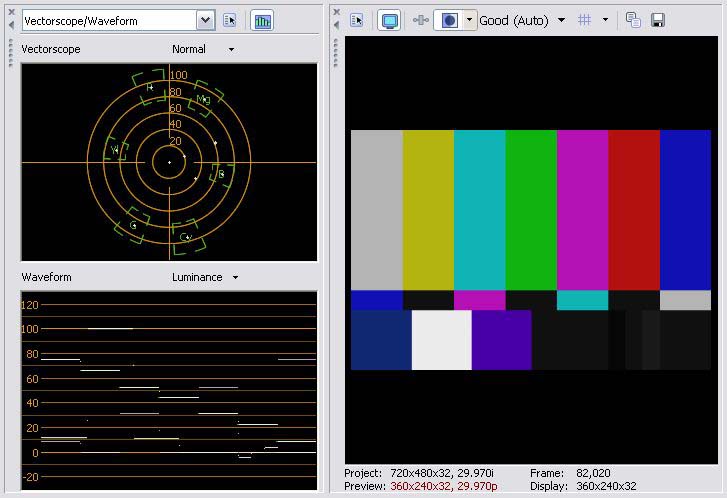
This shows "pass-thru" level 32 black (left) vs. corrected level 16 black (right).
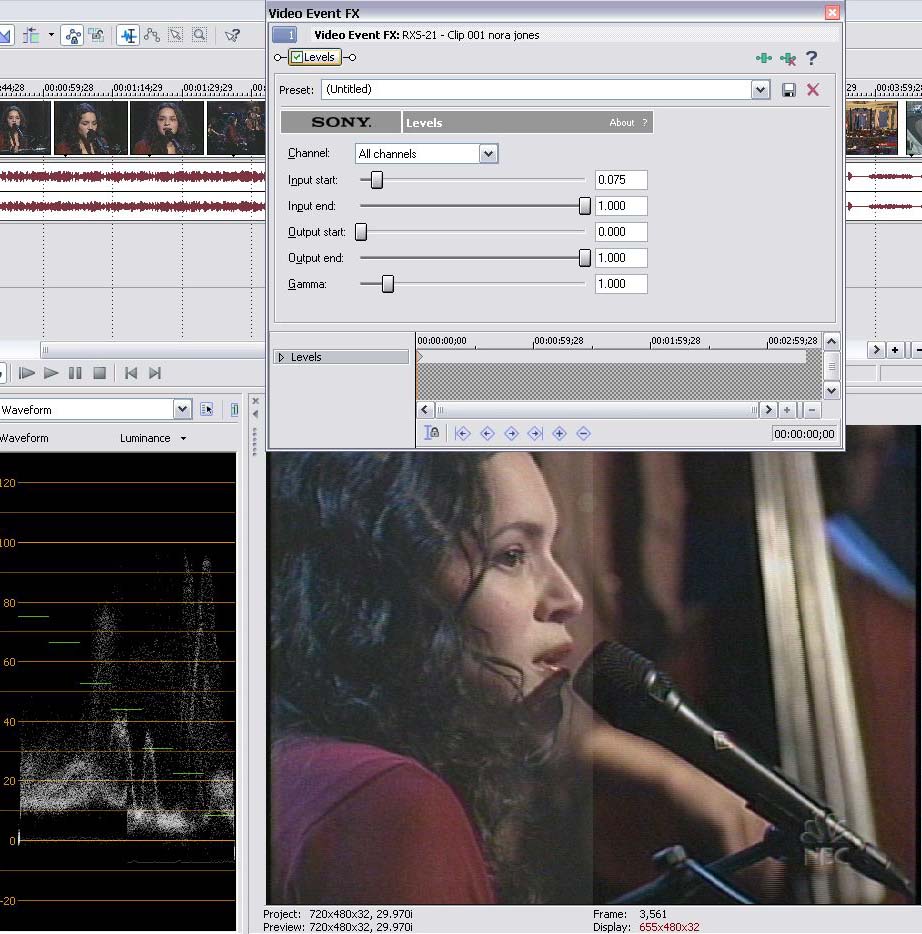
This shows corrected black (left) and crushed black (right).
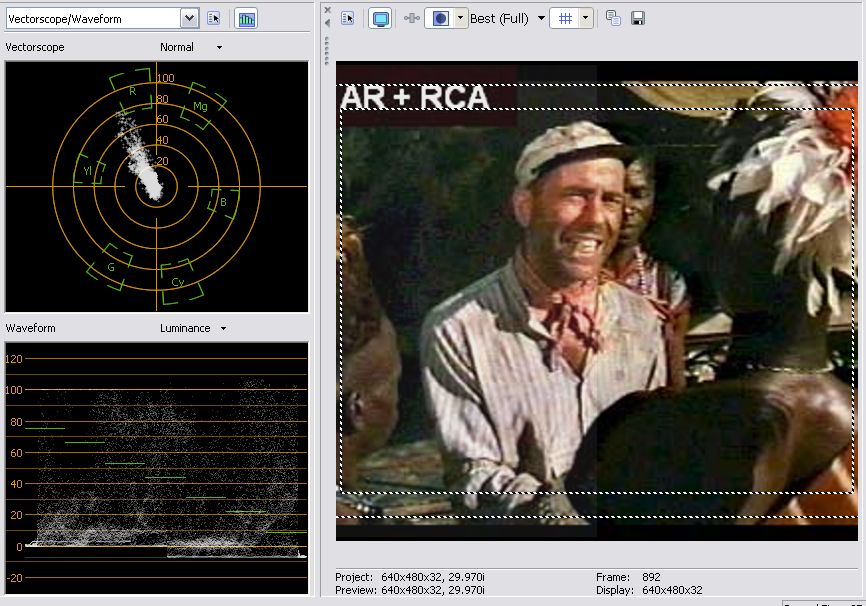
This test slide shows in detail what the DV, DVD-MPeg2 levels are supposed to be.
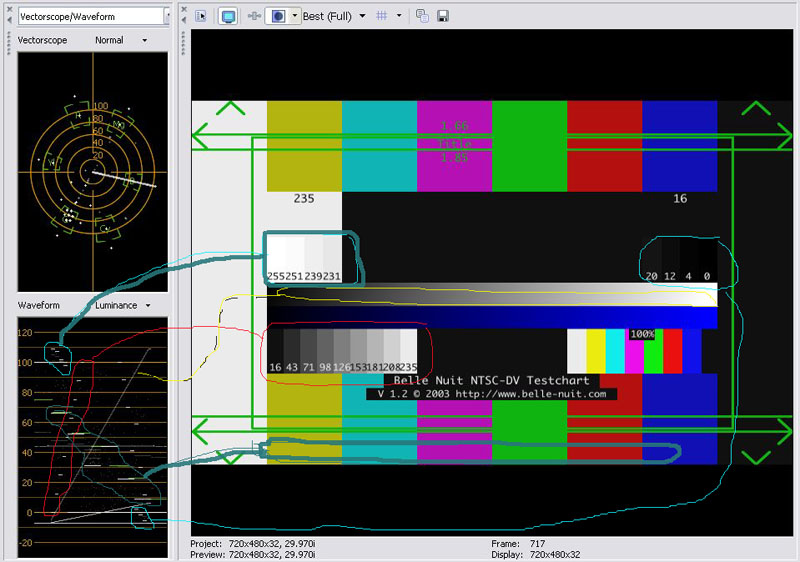
-
The short answer is that if your capturing device does not map analog 7.5 IRE black level sources to digital level 16, or does not have any type of setting to do so, then you will need to adjust the analog video source black level manually with a proc amp down to 0 IRE (while keeping the source peak luma levels at or under 100 IRE using the contrast/video level control) in order to have a correct DVD transfer.
Lite-On DVD recorders sold in North America, for example, do not have a 7.5 IRE black level analog video source setting and will only record a DVD with the correct digital black level if the analog video source being recorded has its black level adjusted to 0 IRE first (or is a 0 IRE black level video source to start with). This is a similar situation as in the "Group 2" devices edDV mentions in his post above... although it is somewhat complicated by the fact that Lite-On DVD recorders sold in North America do add 7.5 IRE black level setup to their composite and s-video output during DVD playback (as should be expected).
So, it depends on the specific DVD recorder or capturing device you are using as to whether manual adjustment of analog video source black level may be required.
Thus, here are two scenarios...
VHS (7.5 IRE) VCR --> Toshiba D-R4 (set to "Standard" input/recording black level): no need to manually adjust the black level of the source because this DVD recorder in this setting will correctly map 7.5 IRE analog video source black level to digital level 16, and the resulting DVD will have correct black level. A proc amp might be used as an option for small image tweaking adjustments in this case.
VHS (7.5 IRE) VCR --> Lite-On LVW-5005: must adjust the black level of the source because this DVD recorder will map 7.5 IRE analog video source black level to digital level 32, and the resulting DVD will not have correct black level (it will look washed out). A proc amp in between the VCR and the Lite-On DVD recorder will be necessary to manually adjust the 7.5 IRE black level analog video source down to 0 IRE black level, which will then be mapped by the DVD recorder to digital level 16 (so the resulting DVD will have correct black level). -
So how do you determine whether your capture card properly records a 7.5 IRE VHS source to 16 Digital black, or whether you need to correct it to 0 IRE to properly create a DVD? With so many manufacturers screwing things up, it doesn't seem like you can necessarily rely on them to get it right.
-
One thing I forgot to point out is DVD MPeg2 and other digital video always use 16-235 scaling regardless of NTSC, PAL or SECAM input and output. The capture and output conversion is part of the DVD Recorder/Player design.Originally Posted by gshelley61
I've noticed that many low end Chinese DVD Players output with 0-100IRE on composite, S-Video and Y. I measured this specifically on a Cyberhome CH-DVD 300 and a Nextbase 9000. This is proper scaling for PAL and Japanese NTSC-J but incorrect for NTSC-M (America). This chart shows that Taiwan is also using NTSC-J with zero setup so this might explain the reason. An alternate reason might be that low end manufacturers want one hardware design to fit all.
http://icecube.wisc.edu/~dima/stuff/comp/vstandards.html
Japanese players like Pioneer and Sony have region specific models and the players that I have measured, each output NTSC at 7.5-100IRE just like a VCR.
Even the test reviews fail to uncover these issues. In the past, one had to rely on a trained eye to see these small black level shifts. In the pro world, test equipment is used to analyze every step. It wasn't until I got Vegas with the calibrated test signals and monitors, that I could measure these things properly at home.Originally Posted by BrainStorm69
The waveform monitor (now included with AVID, Final Cut Pro, Premiere Pro and Vegas) is key to quickly seeing what is happening and what needs fixing. Short of that eyeball techniques need to be developed from test signals and known good clips. -
Yeah, unfortunately I don't have Vegas in my arsenal yet. *sigh* Maybe I need to sell some hardware.Originally Posted by edDV
edDV, do you know what colorspace Vegas works in? Can it work with YUY2, or does it need to be converted to RGB? -
If your TV/monitor is calibrated to your regular DVD player (using the video playback THX test patterns available on some commercial DVD's like Ice Age, Star Wars, etc.), when you play a home made DVD that has incorrect black level you can usually tell right away... in most cases you will perceive the DVD as being washed out, with blacks that look dark gray, poor contrast and dull colors. That's the most common black level problem people have when transferring a North American NTSC 7.5 IRE black level analog video source to DVD or other forms of digital video.
-
@gshelley - that's a good idea. I can compare the ripped Ice Age test patterns to ones I capture with my capture card straight from the DVD.
The other thing I thought I'd do is download the trial version of Vegas to use for whatever time they allow (I think it's two weeks). -
I agree with BrainStorm69 on this.So how do you determine whether your capture card properly records a 7.5 IRE
VHS source to 16 Digital black, or whether you need to correct it to 0 IRE to properly
create a DVD? With so many manufacturers screwing things up, it doesn't seem like you
can necessarily rely on them to get it right.
But, in addition.. the problem is not with the 0 vs. 7.5 IRE, but rather from
the *SOURCE*
I also wanna note first, that it is my belief that Commercial MPEG-2 (on DVD)
is stored at 0-255 levels. And that its up to the set-top dvd players to
do the actual 16-235 levels.. (actually) where:
In addition to this, it is fair to say (based on vast experiences) that notCode:Y: 16-235 Pb: 16-240 Pr: 16-240 or somethimes writen this way, Y: 16-235 Cb: 16-240 Cr: 16-240
all set-up dvd players output proper (converted) IRE levels. Take for an
example my two Apex model players. The AD-500 and AD-1500 both output
different IRE levels. On my AD-500, the output is gray'ish or washed out
looking, though while on my AD-1500, the output looks more blaker (or richer
as I used to term this) and is more appealing to my eyes. But, I sencerely
doubt that even on the AD-1500 player, that it is *NOT* outputing the correct
IRE levels.
I have mentioned this in many past topics elsewheres on this forum.. that
there is at least *one* set-top dvd player that seems to output the correct
IRE levels. And that also goes with their VCR lines as well.
That brand is by Sharp.
To see an example demonstration of this theory, take a look at this thread
topic, where a member was testing various DVD Recorders for best quality
reproduction. Mind you, it wasn't courght/talked about, this on-going thing
about IRE levels, back in that thread, during that time period.
--> Lite-On DVD Recorder Model: 5101 at Sams for $139 any good?
As you can see, from the thread topic above, how much in one of the pics that
was demostrated, how the black levels matche, spot-on! And a few posts down,
this member lists his specs (same subjec thread) -> HERE
So, the test setup was: DVDPlayer[Sharp 600] -> DVDRecorder[220-S]
** Mind you, this is very important to factor in, during testing !!
But, putting another set-top dvd player in this mix above, will more than likely
bring you mixed results, and most probable of unsatisfactionary result.
BAD: ORIGINAL disk vs. iLO DVDR04 dvd recorded disk:
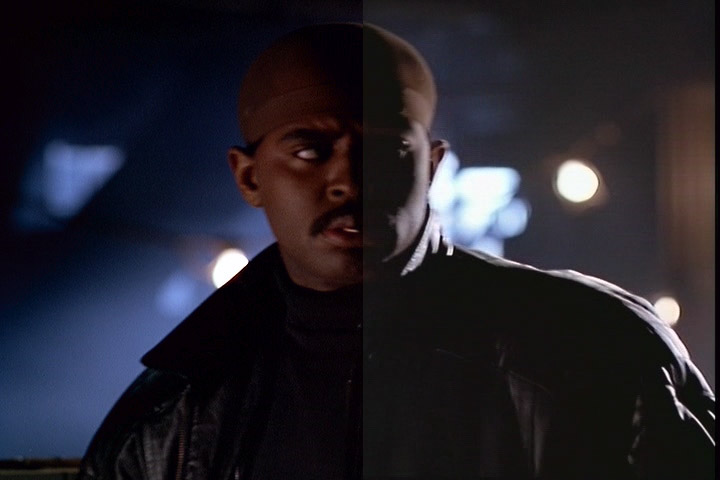
GOOD ORIGINAL disk vs. Pioneer 220-S dvd recorded disk:
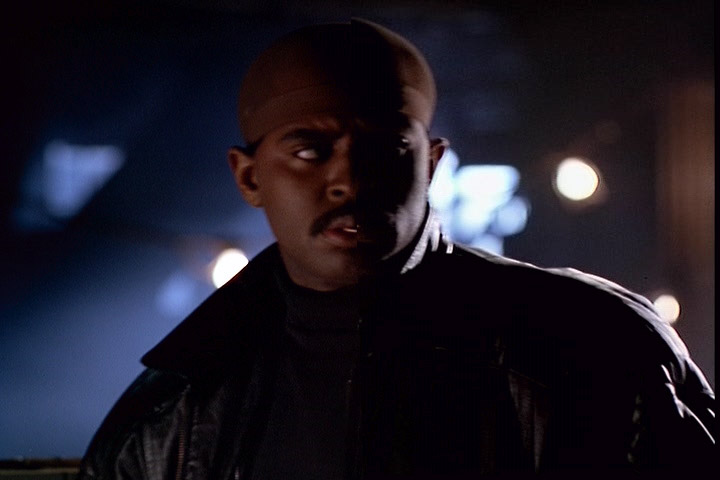
BAD ORIGINAL disk vs. iLO DVDR04 dvd recorded disk:

GOOD ORIGINAL disk vs. Pioneer 220-S dvd recorded disk:

The point of adding in all this demonstartion of pics is to show as evidense
what I am on about, when speaking of having the right mix of units during
testing scenarios. This is a key element that has not been discussed here.
And it is also very important to note. Thus, w/out the proper testing tools,
any results might become stale because of this. So, please keep in mind, that
*known* (tried and true) testing tools (units) need to be considered and used
in these tests.
I had more to say, but I gotta go do something..
-vhelp 3863 -
If the levels are set incorrectly, or adjusted incorrectly, it is possible that the output does not change in level even thought the source level changes. This can be seen in the AVIA PLUGE pattern or a stair-step test pattern. IN the AVIA pattern the 2 and 4 IRE bars, or the 96 or 98 IRE bars may not be visible. In a stair step this would show as some the steps being wider than they should be because two or more input levels are output at the same level. This can dramatically reduce fine detail in either dark or bright scenes.
[/img] -
That will work as long as the source DVD player you are capturing from adds +7.5 IRE setup on the composite and s-video outputs, or has a setting to do so. Nearly all name brand DVD players sold in North America do, although many have an optional "enhanced" black level output setting that removes the +7.5 IRE setup in order to send your TV/display a 0-100 IRE signal (to benefit from DVD's extended video dynamic range). Just make sure when you do these capturing tests that your source DVD player is sending a standard NTSC 7.5-100 IRE signal.Originally Posted by BrainStorm69
Keep in mind that some of the inexpensive secondary brand DVD players do not add +7.5 IRE setup on their video output as they should for North American analog NTSC video specifications. -
I agree with vhelp on the 0-255 "thing".
In perusing the Vegas forums, I find that most posters simply leave their video as is (0-255) when encoding to dvd. The reasons?
1. Most players either clip or blend to 16-235.
2. They don't want to lose their dynamic range.
3. They distribute to more than dvd.
4. Even some broadcasters don't enforce the 16-235 "thing". -
Preparing for a testing scenario..
In realizing this fact, all it would take is to know which unit outputs at
what IRE levels for the proposed test scenario, in order to reach a positive
outcome.
So, lets say that our S-INPUT is VHS for instance, (since we already know at
what IRE level it outputs, its not as important) but, the next check point in
our setup list is to know what our D-INPUT IRE level will output. And if there
will be any other device to further the scenario, ie.. a capture device or
recorder unit, then we need to know it's C-INPUT setup as well
WHERE:
A) source INPUT - would be our source to output video from
B) destination INPUT - the source that will accept, process, and output video
C) capture INPUT - the source that will accept, process, and output video
For A and B, it isn't important to know or even have these values setup, when
all you're doing is watching on your tv set.
But, when you are running various testing scenarios, then it is important to
have everything setup properly, know what and how each item processes and
outputs. Then, in these ase, A and B would be required to be accurate.
Now, as for C, this is important in every scenario because the final outcome
is to reproduce properly and accurately, the source. It is important to get
it right the first time, because you will only have one chance to do it right,
once things are commetted.
As far as finding the equalizer in all this, we can use a DVD source as a
reference to gauge against. Just as the notes I posted earlier on this thread,
the pics demonstrate exactly that.. that gauge. Those pics that were marked
as GOOD are those examples I just commented on, regarding that equalizer
as the gauge.
The point in making these testing scenarios pass flawlessly, is to match the
source.. *not* the standardize specs, even when logic dictates that one should.
(for we are dealing with a greater number of imporperly produced sources these days)
We are trying to reproduce w/out blemish, a given source. To do this, we need
to make certain that the *copy* looks identical to the source.. even if the
source is out of spec -- That is my point. -- And, to try and follow
the standard (according to the specs) is not entirely accurate, nor requried, in
every testing scneario. For if you do go accordinly to the spec, and your source is
out of spec, then *you* are in error, for your testing scenario is flawed.
An example of this flawed is the pic above, where the colors in both frames
do not match. If we were to follow the standard, matching IRE for IRE (but according
to the standard) the pics would be off.
-vhelp 3864 -
Knowing that Japanese NTSC is 0.0 IRE Black but USA NTSC is 7.5 IRE Black I have to ask ... how do they differ on the actual DVD itself.
I would assume that the levels are different i.e., the mapping? In other words the IRE levels on a USA NTSC DVD are different than that on a Japanese NTSC DVD ... correct?
Since PAL is also 0.0 IRE Black then the IRE levels on a PAL DVD would again be different than that on a USA NTSC DVD. Assuming I am correct?
So here is a question that I "deal" with but really have no idea if I'm doing it correctly or not.
How do you deal with the IRE difference if you are re-encoding a PAL DVD to a NTSC DVD? What about a Japanese DVD that is dual layer and you want to re-encode it using a real encoder like CCE so it fits on a single layer DVD. What needs to be done to get a proper USA NTSC 7.5 IRE black level?
Here is what I currently do.
I rip the PAL DVD ... I run it through DGIndex to get a D2V project file. In DGIndex I can pick PC SCALE or TV SCALE. I have been picking TV SCALE. I then use an AviSynth script for the PAL to NTSC conversion (frame size and FPS) and end with ConvertToYUY2() before sending it to CCE. The black level seems to be A-OK when I do this but I assume picking either PC SCALE or TV SCALE in DGIndex is important to get proper black level. In seems in the scenario I just explained that going TV SCALE does the trick.
I use to do the same thing using TMPGEnc Plus instead of CCE but I noticed that I seemed to get better results with TMPGEnc Plus when I used PC SCALE instead of TV SCALE. It has been a long time since I've done PAL to NTSC with TMPGEnc Plus and I forget now if I did or did not checkmark the "Output YUV data as Basic YCbCr not CCIR601" option. I always assumed that PC SCALE in DGIndex (actually back then I was using DVD2AVI but same difference) worked better with TMPGEnc Plus due to the fact that that encoder works in the RGB colorspace whereas CCE does not hence using TV SCALE with CCE.
Am I making any sense?
- John "FulciLives" Coleman"The eyes are the first thing that you have to destroy ... because they have seen too many bad things" - Lucio Fulci
EXPLORE THE FILMS OF LUCIO FULCI - THE MAESTRO OF GORE
-
No. In digital video, including DVD's, the standard CCIR601 range is 16-235 digital video level, 16 being equivalent to video black and 235 being video white. There is no difference in terms of encoded video levels between a North American NTSC DVD, and Japanese NTSC DVD, or a European PAL DVD. 0-15 and 236-255 are reserved for video black undershoot (blacker than black) and video white overshoot (whiter than white), respectively.
The difference occurs in the hardware the DVD's are played back on. In North American spec DVD players, the digital video data is converted to an analog NTSC signal, including adding +7.5 IRE black level setup to the composite and s-video outputs. In European and Asian DVD players, no black level setup is added because their analog video standards are 0-100 IRE, 0 IRE being the correct analog video black level for all the world (except for North America, where it is 7.5 IRE for analog NTSC).
This does not apply at all in the digital video world, where the analog IRE standards are not applicable. The worldwide standard for all digital video intended for broadcast or home video, regardless of video system or standard, is 16-235.
I think that the 0-255 digital value scale range that some folks bring up, where 0 is black and 255 is white, has applications in RGB computer graphics work. It does not apply to digital video intended for broadcast and home video use. -
hey Fulci,
Well, if you use the tv scale, then you are seting up for a 16-235 (tv scale)
(this is evidense by observing how your video is brighter looking)
But, if your dvd's are 0-255 scale, you should be setting up for 0-255 or
pc scale
IMHO, I think that its wrong to use this setup (tv scale vs. pc scale) for
dvd source because like I commented above, they are all pretty much 0-255
scale to begin with.
(It is my personal opinion that PC Scale should used by default)
But, there could be a catch. And, you have to be a skillful person to know
this. - (but I'll tell you now) - Your MPEG encoder..
** What-does-it-do-to-your-source ??
A, does it leave it at 16-235 and process it as 16-235 straight to MPEG ??
B, does it process it as-is, and converting to again, further, using 16-235
... as if it were 0-255 (not that it would see it as such) ??
What I mean by B, is this. Say your setup for a TV Scale param [16-235] and
run this through your paculiar MPEG encoder. Does your mpeg encoder see this
source as-is, and runs it through a TV Scale [or 16-235] conversion again,
there-by making it lighter or whatever compounding the video's outcome would be ??
The only way to know this, is to test it out for yourself. Remember to also
note what I commented on preiviously above. Use the DVD source as the guage,
*not* the standardized spec. Your dvd is the guage. Process your PAL->NTSC
conversion to MPEG, and see if they both match, as in the pics I demonstrated
above. Thus..
** If your setup is TV Scale [16-235] and encoded, and analized = matched
** If your setup is PC Scale [0-255] and encoded, and analized = matched
then you have your answee
But, the final answer lies in your MPEG Encoder
-vhelp 3866 -
Well I have the UK 16x9 WS PAL DVD of PHANTASM III and I recently converted it to a 16x9 WS NTSC DVD ... so in order to see if they match here is what I did ...
I ripped the original UK 16x9 PAL DVD and did a screen grab ... I loaded a VOB directly into VirtualDubMod then did a copy and paste into Photoshop where I saved it as a JPG in the original 720x576 resolution.
I ripped the converted 16x9 WS NTSC DVD I created and did a screen grab ... I loaded a VOB directly into VirtualDubMod then did a copy and paste into Photoshop where I saved it as a JPG in the original 720x480 resolution.
Here are these two screen grabs:
PHANTASM 3 - Original UK 16x9 WS PAL DVD screen grab (720x576)
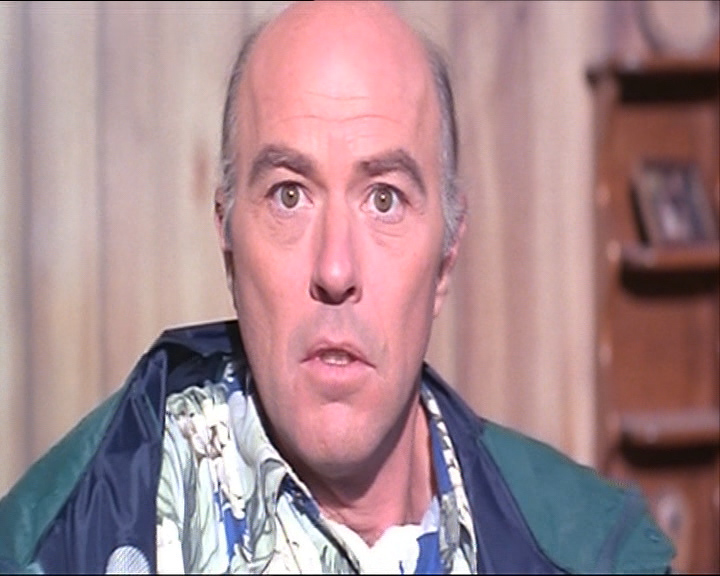
PHANTASM 3 - Converted 16x9 WS NTSC DVD screen grab (720x480)
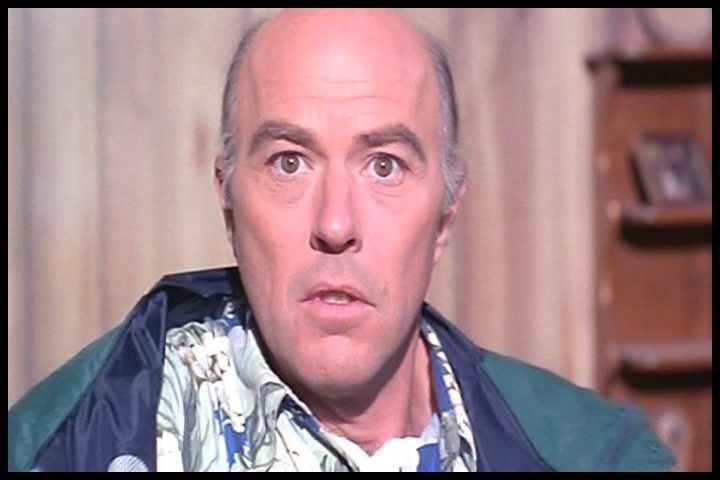
Below is a composite image. Using Photoshop I resized the PAL screen grab (seen above at 720x576) to 720x480 then cut off 360 pixels from the right (making it 360x480) ... I then took the NTSC screen grab (seen above) and cut off 360 pixels from the left (making it 360x480). I then combined the two images to make a single 720x480 image and that image has the PAL on the left and the NTSC on the right with the split exactly down the center of the image. I did a wee bit of masking around the edges when I did the PAL to NTSC conversion so you can tell where one side ends and the other begins due to that masking otherwise they match up nearly perfectly (I managed to grab the exact same frame from each DVD source).
PHANTASM 3 - Original PAL on the LEFT and the converted NTSC on the RIGHT (720x480)
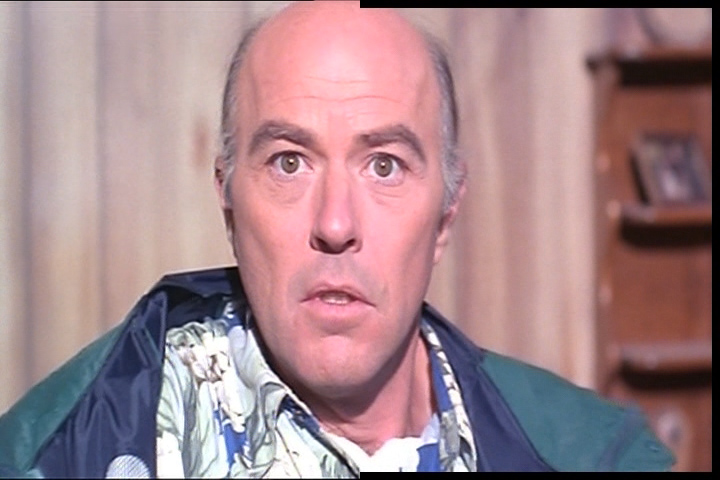
As you can see they do match pretty much perfectly so that makes me happy
As I said in my post above the PAL DVD was run through DGIndex using TV SCALE then I used an AviSynth AVS script into CCE SP for the conversion and re-encode. I try to save my scripts and I found the one I used for this project so here it is:.
The resulting MPV video file was run through DGPulldown to do the 25fps ---> 29.970fps thing.Code:LoadPlugin("C:\Program Files\AutoGK\DGMPGDec\DGDecode.dll") LoadPlugin("C:\COPY_DVD\decomb\decomb521.dll") LoadPlugin("C:\Program Files\AutoGK\filters\RemoveGrainSSE2.dll") MPEG2Source("C:\PHANTASM_III\VIDEO_TS\WORK\movie.d2v") FieldDeinterlace(full=false) RemoveGrain(mode=2) LanczosResize(720,480) crop(8,8,-8,-8) AddBorders(8,8,8,8) ConvertToYUY2()
Anyways the point of this was that I thought that maybe I wasn't doing things 100% correct in relation to all this IRE "nonesense" but I guess I am doing it correct plus I think I have a better understanding now of IRE levels ... at least when it comes to commercial DVD releases.
I hope others find this usefull
- John "FulciLives" Coleman"The eyes are the first thing that you have to destroy ... because they have seen too many bad things" - Lucio Fulci
EXPLORE THE FILMS OF LUCIO FULCI - THE MAESTRO OF GORE
-
Here's some answers about DVD encoding, and TV video digital level scale. It is true that the digital video files on DVD's actually do include all the video levels from 0-255, even though the TV digital scale is 16-235. The room at the ends of the scale is for blacker than black and whiter than white digital video information.
For example, the THX DVD black level test pattern includes blacker than black areas (the dropshadow of the THX logo and the two darkest blocks in the horizontal gray scale are blacker than black... that is, they are encoded below digital level 16). To properly calibrate your TV/display black level, you are advised in the test pattern instructions to adjust your TV/display brightness so that the THX logo is just visible, and so that the 7th gray scale block is barely discernable from the 8th block. The 9th and 10th blocks should not be discernable from the 8th block, because they are blacker than black. The 8th block is the digital 16 level block (TV video black).
Here's the THX test pattern for gray scale:

And here is the histogram for this frame:
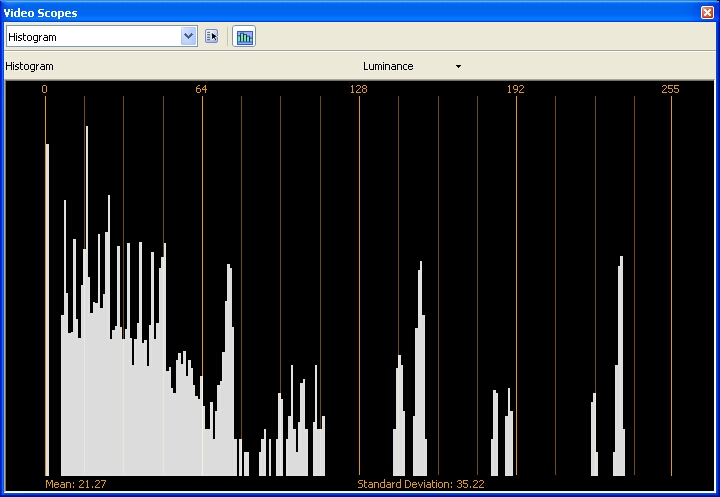
Notice how the blacker than black data is in fact encoded in the DVD MPEG2 video file (below level 16) but does not exceed 235 in this frame because the white block in the test pattern is a standard 100% white level block (not whiter than white).
Here's the THX multipurpose test pattern:
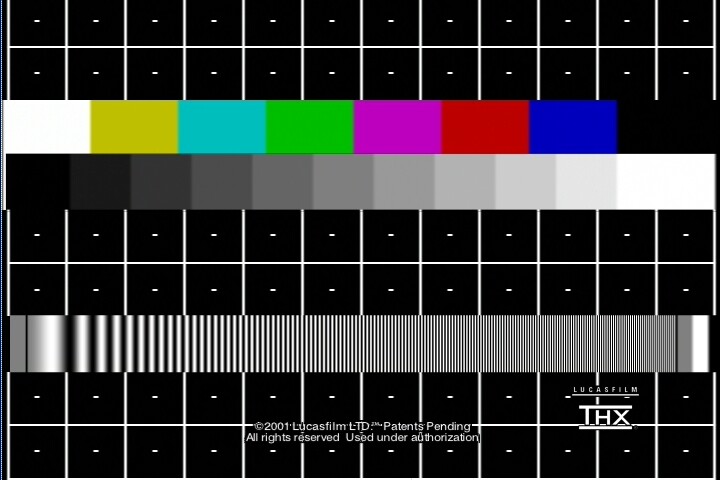
And here is the histogram for this test pattern:
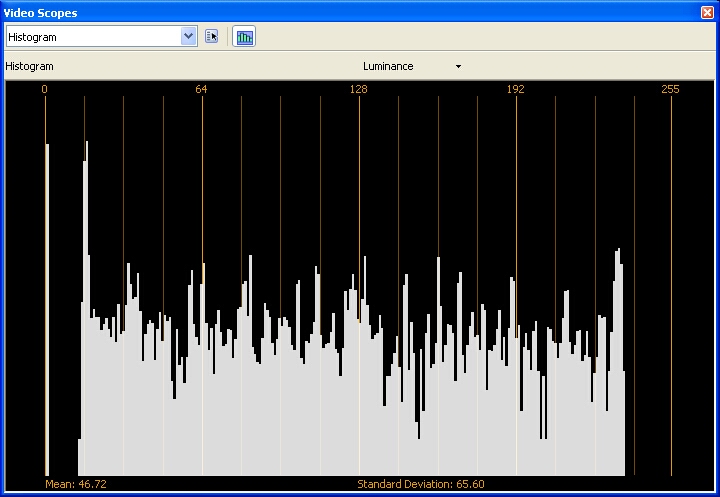
In this case, the test pattern only includes normal video information from level 16 (black) to level 235 (white).
Again, you want your TV video information to stay within the 16-235 digital level scale, where 16 is video black and 235 is video white. The areas above and below the scale are for blacker than black and whiter than white peaks, but are not part of the normal (visible) digital video scale for TV. -
AMEN brotherOriginally Posted by gshelley61

I was just writing the same thing. While looking for references, I came across this article that is packed with useful technical information on the DVD standard and the ways to measure DVD player performance. I highly suggest people try to understand players at this techincal level. It makes so many of the issues brought up here very clear. I had missed his update in March, 2005.
http://www.hometheaterhifi.com/volume_7_3/dvd-benchmark-part-1-video-9-2000.html -
fulci, I will give your latest demonstration some reading and also do
some encoding (based off your first PAL pic) with the methods that I
use in my video processing.
But, from the work you performed on those pics above, I would say that
everything looks spot-on. And, I wouldn't change a thing. Course, I
don't do PAL materials. And your pic would be my first. I can still
work off your pic, assumg your origianl PAL pic is not tainted. I'll
assume its clean ..I'll use it for my own purposes, and try and come
..I'll use it for my own purposes, and try and come
back with results, or at least a positive response.
Thanks for contributing
-vhelp 3868 -
I could always take the ripped VOB files from the original PAL DVD and cut out a short bit and send it to you. That way you have the original source. This is a commercial film but for testing purposes and since the edited VOB would be very short (like 10 seconds or less) then I think it would be considered A-OK.Originally Posted by vhelp
I just have to make sure I have enough website space to host it plus I never tried to cut a VOB file before but I see a program called VobEdit in the TOOLS SECTION so I guess that would work.
- John "FulciLives" Coleman"The eyes are the first thing that you have to destroy ... because they have seen too many bad things" - Lucio Fulci
EXPLORE THE FILMS OF LUCIO FULCI - THE MAESTRO OF GORE
Similar Threads
-
Pioneer Elite CLD-99 laserdisc player - black levels?
By echo1434 in forum RestorationReplies: 40Last Post: 15th Oct 2012, 20:39 -
Black Levels in Windows Media Center using Hauppauge HD PVR
By Mitterhouse in forum Capturing and VCRReplies: 0Last Post: 17th Jun 2011, 14:16 -
Correct Black Levels
By MasterOfPuppets in forum Capturing and VCRReplies: 7Last Post: 10th Jul 2010, 16:38 -
Confused about black levels... again.
By binister in forum Newbie / General discussionsReplies: 5Last Post: 16th Dec 2008, 21:43 -
How do I merge 2 AVI to DVD adding saturation +black levels?
By JoeBolden in forum Video ConversionReplies: 2Last Post: 23rd Jul 2008, 13:01




 Quote
Quote